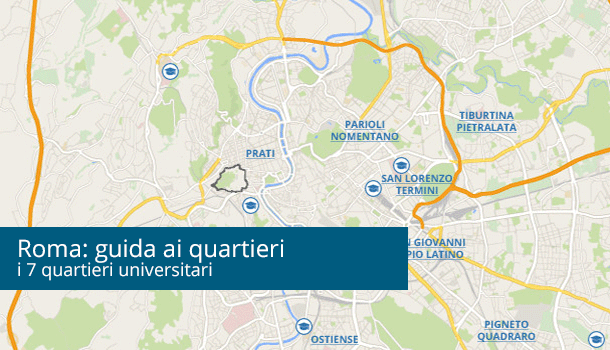“Rome is eternal. “Rome is dead.” “Rome is splendid.” “Rome sucks. “Rome is a city where I would never live.” “Rome is the only city where I could live.” However you experience it, Rome is a city full of contradictions. Imposing and cramped. Decadent and beautiful. Vulgar and sublime. He carries all the weight of his years but also a certain lightness that makes his flaws look like mistakes of youth.
Because, as Ennio Flaiano said, “Sometimes I may hate it, but Rome is unknowable, it reveals itself over time and not entirely. It has an extreme reserve of mystery and still some oasis.”
In order to be able to find a personal “oasis of happiness” among dolce vita and great beauty, mundane terraces and busy houses, we tried to draw up 7 main areas where a student (but not only) can start looking.
Seven like the hills that hold up its historic center and like the kings who made it mythical. Aware that attempting to narrate Rome means always rounding down…
If you are looking for a room or apartment for
for rent in Rome
, start here…choosing the right area, can change your life.
San Lorenzo – Termini
A university district par excellence, it houses right in its heart the University City, the main hub of Sapienza strongly desired by Mussolini. The designation of City is not a legacy of fascist magniloquence, but indicative of the order of magnitude, since it houses the main buildings of the largest university in Europe, plus an entire hospital housing the Faculty of Medicine. Nearby, it teems with a great buzz of life, the result not only of the young average age of the inhabitants, but also of a working-class background that is very proud of the neighborhood’s history. Nightlife is lively and very student-friendly, thanks in part to the dense presence of plazas and clubs. The exception is house prices, which tend to be medium to high in the face of apartments that are not always in the best condition.
Tiburtino – Pietralata
Because of its imbalance between social popularity and real estate unpopularity, San Lorenzo finds its “branch” in the extension of Via Tiburtina that goes beyond the inner ring road and the railroad tracks. Around the “high” Tiburtina–between Casal Bertone, Casal Bruciato and Monti Tiburtini–many students thus end up settling, attracted by affordability and proximity to both San Lorenzo (Sapienza) and the northeast branch of Metro B (the line leading to Roma Tre). All around, very popular neighborhoods, each with its own inner life.
Ostiense – St. Paul
The southwest area, on the other hand, is the most popular destination for students from another university cluster-Roma Tre. The newest among the three public universities in the capital is located mainly on the first section of the artery that runs from the Pyramid Cestia to Eur and then continues to Lido di Ostia. Here, too, the proximity to university complexes combined with the vital soul of neighborhoods such as Testaccio or Garbatella pleasantly welcomes even the most down-and-out student with a rather active and varied nightlife. Prices fluctuate greatly depending on the elevation at which you choose to locate yourself (more expensive near Ostiense station, lower as you go down toward Magliana). The good presence of means (bus, metro B and trains) and the fair proximity to the famous Trastevere should be considered.
Nomentano – Parioli
Beyond the “ramparts” of Piazza Bologna, the dimension of “Roma Bene” begins. It feels like crossing a border or a space-time gateway, such is the difference from other neighborhoods. Very residential neighborhoods, full of cottages, parks and gardens. And where rents and the cost of living are beginning to be decidedly affordable for a few. It houses the headquarters of LUISS, Sapienza’s Departments of Communication and Social Research, and extends to Valle Giulia, the main site of Architecture and of the famous clashes between students and police in ’68. The evening life looks a lot like what you might find around Milan’s Navigli, especially if instead of stopping only between Corso Trieste and Piazza Fiume, you go as far as the Montesacro area around the Aniene.
San Giovanni – Appio Latino
St. John’s is a kind of free zone: a borderland, a multifaceted heath. It somewhat encapsulates all aspects of the previous neighborhoods and is both near and far from everything. Very residential and prone to nightlife only in short stretches, it has on its side apartments in good condition and non-prohibitive rents. Practically equidistant from the three public universities (it is the most “convenient” area of central Rome from which to reach the suburban university of Tor Vergata), it stretches along the commercial artery of Appia Nuova and the southeast arm of the Metro A. Which, by most accounts, is the only true metro line in the capital.
Pigneto – Quadraro
The area of “gentrification,” or major urban and socio-culturalferment, such as Williamsburg in New York or Kreuzberg in Berlin. This was to be the fate of East Rome in the part that extends below the long arm of the Via Prenestina to involve Quadraro and Tuscolano. Very popular rents, a “de borgata” soul, a pronounced multiethnicity and an aura of cinematic imagery ranging from the Pigneto street of Pasolini’s “panhandlers” to the Cinecittà studios have made it a favorite destination for young artists and students of dams, fashion or design for years. Then, something must have gone wrong, and the surge of innovation soon turned into a long lull with moments of decay. However, against the backdrop of still very competitive prices, a fairly active nightlife and fairly agile commuting (traffic permitting). While waiting for the long-awaited Metro Cto arrive…
Meadows
The area from St. Peter’s and Castel Sant’Angelo to the slopes of Monte Mario is the favorite part for foreign students and workers. Those looking for a quiet neighborhood, very close to the historic center and the headquarters of banks and large businesses. But more importantly, with a road network and vehicle density that the rest of Rome dreams of. That said, unless you attend Lumsa or a pontifical university, it is definitely the least university-like of the neighborhoods mentioned. With a fairly high price range and a density of commercial establishments decidedly skewed toward stores and shopping rather than nightclubs.
Ti potrebbe interessare anche:

Pubblicato il 19-05-2023 11:05:53

Pubblicato il 13-05-2023 15:34:33
Pubblicato il 09-05-2023 14:39:52

Pubblicato il 09-01-2023 10:14:51

Pubblicato il 05-01-2023 13:04:04
